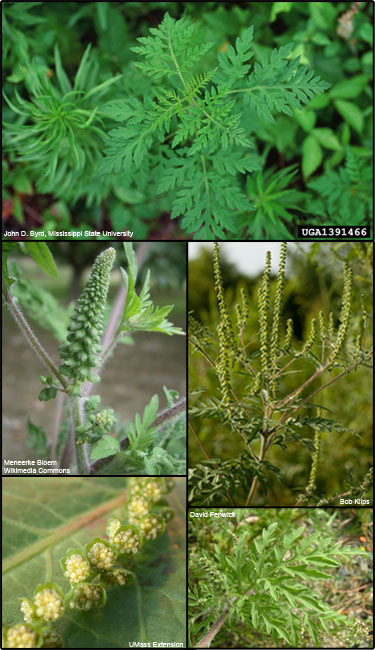Common ragweed (Ambrosia artemisiifolia)
 Common Names: Annual ragweed, Roman wormwood, low ragweed, short ragweed, small ragweed
Common Names: Annual ragweed, Roman wormwood, low ragweed, short ragweed, small ragweedDescription: Considered invasive due to its competitive nature.
Habit: Ranges from 3-6 ft, branches frequently when population densities are low, shallow taproot, fiberous root system, abundant pollen.
Leaves: Cotyledons are thick and oval to spatula-shaped, leaves are fernlike, once or twice compound and usually hairy, upper leaves are alternate, lower leaves may be opposite or alternate with distinct petioles.
Stems: Usually hairy; erect and branched up to 6 ft tall.
Flowers: Generally inconspicuous, found on terminal branches, produces a prolific amount of pollen.
Fruit and seeds: Seed is enclosed in a single-seeded, woody fruit with several spikes resembling a crown.
Habitat: Native to North America. Grows well in poor soil.
Reproduction: By seed. Plants can produce up to 3500 seeds.
Similar species: Giant Ragweed (Ambrosia trifida); Western Ragweed (Ambrosia psilostachya).
Monitoring and rapid response: Effectively controlled using any of several readily available general use herbicides. Credits: The information provided in this factsheet was gathered from the MSU Pest Management and the USDA PLANTS Database.
Individual species images that appear with a number in a black box are courtesy of the Bugwood.org network (http://www.invasive.org).Individual photo author credits may not be included due to the small display size of the images and subsequent difficulty of reading the provided text. All other images appear courtesy of Google (http://images.google.com).
Common Name: | Common ragweed |
Scientific Name: | Ambrosia artemisiifolia |
Family: | Asteraceae (Aster) |
Duration: | Annual |
Habit: | Herbs |
USDA Symbol: | AMAR2 |
